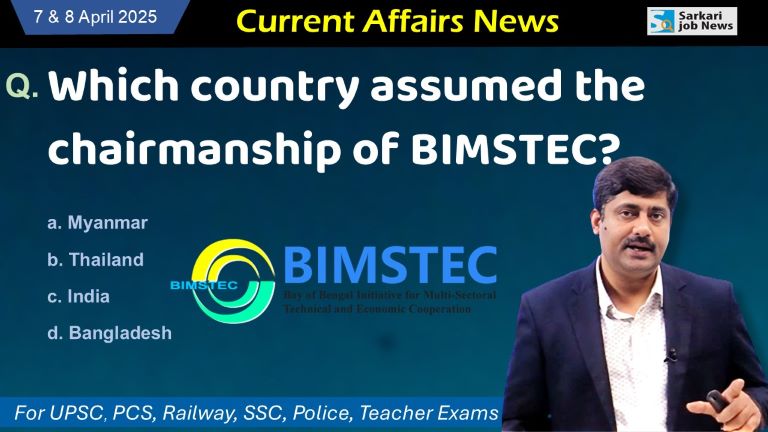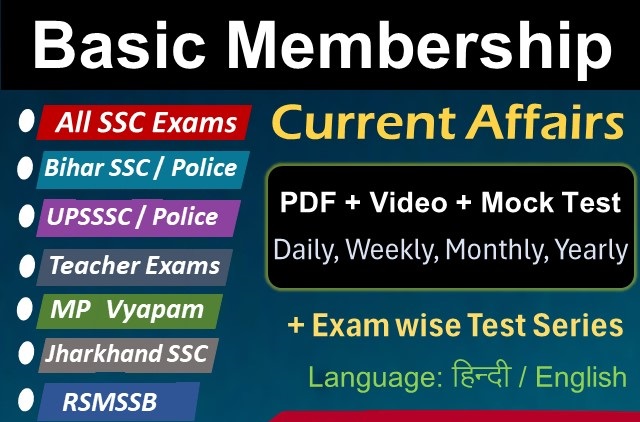This is the current affairs of 7 & 8 April 2025. Here are questions and answers of daily current affairs for better preparation of competitive exams for government jobs.
PDF Download: Click here
1. On March 7, 2025, due to the announcement of reciprocal tariffs by U.S. President Donald Trump, there was a significant decline in stock markets worldwide.
– However, due to Trump’s stubbornness, the world is heading toward a global recession.
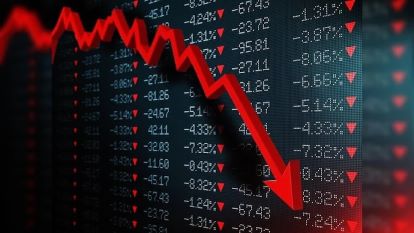
3 Reasons for the Market Decline:
– Trump’s Reciprocal Tariff: The U.S. has announced a 26% tariff on India. Apart from India, tariffs will be imposed on China (34%), the European Union (20%), South Korea (25%), Japan (24%), Vietnam (46%), and Taiwan (32%).
– China’s Counter Tariff of 34%: China announced a counter-tariff of 34% on the U.S. on Friday. The new tariff will be implemented starting April 10. On April 3, U.S. President Trump had imposed reciprocal tariffs worldwide, including an additional 34% tariff on China. Now, China has imposed the same tariff on the U.S.
– In Response, Trump Threatens to Increase Reciprocal Tariffs to 50%
– Concern over Economic Slowdown: When tariffs make goods more expensive, people buy less, which could slow down the economy. Additionally, reduced demand has caused a drop in crude oil prices, indicating weaker economic activity.

India’s Market Might Remain Safe:
– India’s economic growth has slowed down to 6-7%, and it might drop to 5%.
– Our country is not as vulnerable as most developed nations.
– However, even a 1% decline will impact our development targets.
– To become developed, a GDP growth rate of 10% or more is needed. A lower growth rate will affect industries here.
– Our market will be impacted, which is why stock market indices have fallen here as well.
India’s Exports Will Decline:
– India’s exports to the U.S. in 2025 are expected to decrease by $5.76 billion to $84 billion. This will be a 6.45% decline compared to India’s exports to the U.S. of $89.81 billion in 2024 (U.S. data).
Is a Recession Coming?
– The 2008 recession was particularly in the housing sector.
– The current crisis will affect the entire global economy. No sector will remain unaffected.
– Tariffs have been imposed on goods, but services will also be impacted soon.
– No sector will be spared.
– There has been no greater uncertainty in the world in the past 100 years.
– If Trump and the U.S. do not retreat in the next three months, the situation will worsen.
– American importers worldwide will buy fewer goods, leading to reduced consumer goods purchases. As a result, global production will decrease, causing economic devastation.
– If Trump does not roll back the tariffs, this will not stop.
Why Is Trump Doing This?
– Most countries will not fall under Trump’s influence on this issue and will not negotiate.
– Some may try, but only to offer zero tariffs or equal tariffs, but Trump is not likely to accept it.
– Tariffs are not very high globally. China’s tariff is around 8-9%, and Japan’s is around 3%. Even if these were reduced to zero, Trump would not accept it.
– Trump wants to eliminate the trade deficit. If there is a $1,200 billion trade deficit today, he wants it reduced to zero.
– He wants countries to reduce prices of the things they supply to eliminate this deficit, or buy goods at such prices that the trade deficit becomes zero.
– Both of these options are impossible. The world doesn’t have enough margin to reduce the prices of goods.
– Trump doesn’t see services, where there is a $300 billion surplus.
– Since the U.S. is the largest investor globally, it stands to gain, but Trump is only concerned with mercantile trade.
Countries around the World Are Opposing:
– Canada and China have retaliated, and these countries are reducing imports of American goods. Europe is also likely to do the same.
– As a result, producers in the U.S. will face losses.
Unemployment Will Rise in the U.S. after Trump’s Actions:
– The U.S. economy is service-based, with 80-85% of GDP coming from services.
– Europe is considering imposing tariffs on American services.
– If services are affected, unemployment in the U.S. will increase.
– This is why many people are opposing Trump’s actions.
What Is an Economic Recession?
– A recession refers to a long-term slowdown or stagnation in any economic activity. When a country’s economy contracts for two to three consecutive quarters instead of growing, it is called a recession.
– The total value of all goods and services produced in a country in one year is called GDP. If GDP figures begin to fall, it signals the threat of a recession.
When Does a Recession Happen? What’s the Link Between Inflation and Recession?
– For instance, if the price of samosas increases, you might stop buying them. This will affect the income of the seller, and they might produce fewer samosas, which in turn affects suppliers of potatoes and oil. Such interconnected chains exist in any economy.
– A recession in a country occurs when these interconnected chains experience a domino effect. It is a vicious cycle where everything is interlinked. The cycle continues until the economy contracts.
What Is the Impact of a Recession on Ordinary People?
– A country facing a recession can have dangerous consequences. The investment climate can deteriorate.
– Reduced consumption and sales can lead to the closure of many businesses, causing job losses. Ordinary people and businesses might struggle to pay off their debts, and many may even go bankrupt.
How Will a U.S. Recession Affect the World?
– The U.S. is the largest economy in the world, and its economy is connected to the global economy. If the U.S. enters a recession, a large part of the world will be affected. For example, the mere threat of a recession has caused a sharp drop in Asian stock markets, including India.
Source: New York Times | Economic Times | The Hindu Business Line
—————–
2. PM मोदी की श्रीलंका यात्रा के दौरान वहां के राष्ट्रपति ने कौन सा सम्मान दिया?
Which honour did the President of Sri Lanka give to PM Modi during his visit to Sri Lanka?
a. Sri Lanka Ratna
b. Mitra Vibhushan
c. Mitra Ratna
d. None of these
Answer: b. Mitra Vibhushan
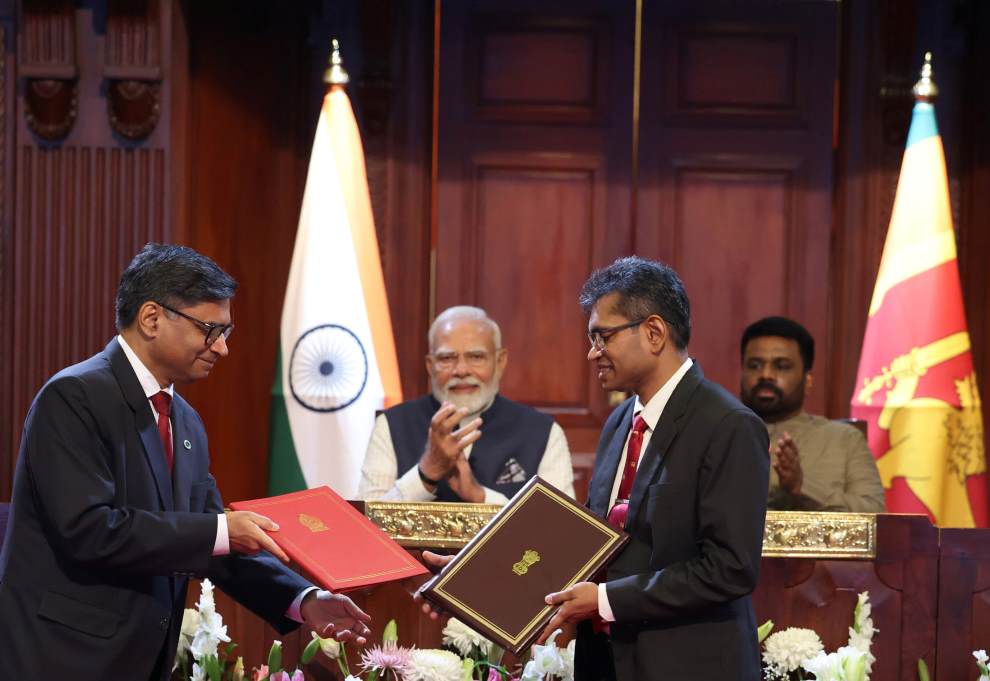
– The ‘Mitra Vibhushanaya’ award is the highest civilian honour given by Sri Lanka to a foreign head of state.
Sri Lanka
President – Anura Kumara Dissanayake
Prime Minister – Harini Amarasuriya
Capital – Sri Jayewardenepura Kotte (legislative) and Colombo (executive and judicial)
Currency – Sri Lankan Rupee
Source: India Express
—————
3. In which country was the 6th BIMSTEC Summit 2025 held, in which PM Modi participated?
a. Myanmar
b. Malaysia
c. Singapore
d. Thailand
Answer: d. Thailand (held in April 2025 in the capital Bangkok)
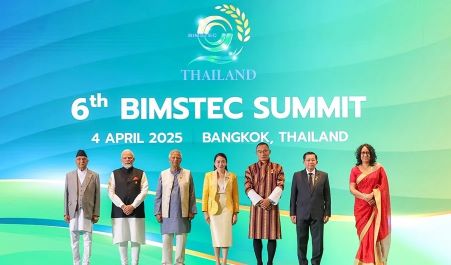
About BIMSTEC:
– Full Name: The Bay of Bengal Initiative for Multi-Sectoral Technical and Economic Cooperation.
– Headquarters: Dhaka, Bangladesh.
– Member Countries: Bangladesh, Bhutan, India, Myanmar, Nepal, Sri Lanka, and Thailand.
– Formation: BIMSTEC was established in 1997 as BIST-EC (Bangladesh, India, Sri Lanka, and Thailand Economic Cooperation). Later, Myanmar, Nepal, and Bhutan joined, and it was renamed BIMSTEC.
– Objective: To promote technical and economic cooperation among the South Asian and Southeast Asian countries along the Bay of Bengal.
– Region Coverage: BIMSTEC includes countries surrounding the Bay of Bengal. These seven countries are home to approximately 22% of the world’s population.
– Key Areas of Cooperation: The 14 key sectors in BIMSTEC include:
– Trade and Investment
– Transport and Communication
– Energy
– Tourism
– Technology
– Fisheries
– Agriculture
– Public Health
– Poverty Eradication
– Counter-Terrorism and Transnational Crime
– Environment and Disaster Management
– People-to-People Connectivity
– Cultural Cooperation
– Climate Change
China’s Interest:
– The Bay of Bengal is important for China as it seeks to maintain its access route to the Indian Ocean.
– China has launched a major infrastructure financing and construction campaign through its Belt and Road Initiative (BRI) in almost all BIMSTEC countries, except Bhutan and India. This has turned the BIMSTEC region into a new battleground for the India-China dominance struggle.
—–
Who participated in the sixth summit:
1. Chief Advisor of Bangladesh – Muhammad Yunus
2. Prime Minister of Bhutan – Dasho Tshering Tobga
3. Prime Minister of India – Narendra Modi
4. Prime Minister of Myanmar – General Min Aung Hlaing
5. Prime Minister of Nepal – KP Sharma Oli
6. Prime Minister of Sri Lanka – Dr. Harini Amarasuriya
7. Prime Minister of Thailand – Patongtarn Shinawatra
Decisions Made at the 6th BIMSTEC Summit:
Business:
– The BIMSTEC Chamber of Commerce was established.
– An annual BIMSTEC Business Summit will be organized.
– A feasibility study will be conducted on the option of trading in local currencies within the BIMSTEC region.
IT (Information Technology):
– A pilot study will be conducted to understand the needs of BIMSTEC countries, where Digital Public Infrastructure (DPI) experiences will be shared.
– Direct connectivity between the payment systems of the BIMSTEC region and India’s UPI (Unified Payments Interface) will be established.
Disaster Management:
– A BIMSTEC Center of Excellence for Disaster Management will be set up in India, which will help in disaster relief and rehabilitation.
– In 2025, India will host the 4th Joint Exercise of BIMSTEC Disaster Management Authorities.
Security:
– For the first time, a BIMSTEC Home Ministers’ Meeting will be held in India.
Space:
– Ground stations will be established for BIMSTEC countries where manpower training, nano satellite manufacturing and launching, and the use of remote sensing data will take place.
Capacity Building and Training:
– Under the “BODHI” initiative (BIMSTEC for Organised Development of Human Resource Infrastructure), 300 youth from BIMSTEC countries will come to India for training every year.
– BIMSTEC students will receive scholarships at the Forestry Research Institute of India, and the Nalanda University Scholarship Scheme will also be expanded.
– A training program for young diplomats from BIMSTEC countries will be conducted every year.
– The Tata Memorial Centre will support cancer care training and capacity building in BIMSTEC countries.
– A Center of Excellence will be established for research and awareness in traditional medicine.
– Another Center of Excellence will be set up for farmers where knowledge exchange, research, and training will be provided.
Energy:
– The BIMSTEC Energy Centre in Bengaluru has started functioning.
– The project for electric grid interconnection is progressing rapidly.
Youth Engagement:
– The BIMSTEC Young Leaders Summit will be held in 2025.
– A BIMSTEC Hackathon and Young Professional Visitors Program will also be launched.
Sports:
– India will host the BIMSTEC Athletics Meet this year.
– The first BIMSTEC Games will be hosted in 2027.
Culture:
– The BIMSTEC Traditional Music Festival will be held in India this year.
Connectivity:
– A Sustainable Marine Transport Centre will be established in India, focusing on capacity building, research, innovation, and marine policies.
Note: The first Indian to become the BIMSTEC Secretary-General in 2024 is Indramani Pandey.
Thailand:
– King: Maha Vajiralongkorn (Rama X)
– Prime Minister: Paetongtarn Shinawatra
– Language: Thai
– Currency: Thai Baht
– Neighboring Countries: Myanmar, Laos, Cambodia, and Malaysia.
India-Thailand Relations – Over 2000 Years Old:
– The relationship between India and Thailand dates back to over 2000 years.
– In ancient times, Buddhism and Hindu culture from India spread to Thailand.
– During the reign of Emperor Ashoka, Buddhist monks spread the teachings of Buddha in Thailand.
– Thailand was referred to as ‘Suvarna Bhoomi’ (Land of Gold) in ancient Indian scriptures.
– After India gained independence in 1947, both countries formalized their relations.
– In 2022, India and Thailand celebrated the 75th anniversary of their diplomatic ties.
– During the Cold War era, when the world was divided between the US and Russia, both Thailand and India remained non-aligned.
Thailand as India’s 4th Largest Trade Partner:
– In 2021, the Thai company Global Renewable Synergy Company Limited made a major investment of ₹3880 crores in India’s renewable energy sector.
– Among ASEAN countries, Thailand is India’s fourth-largest trading partner after Singapore, Indonesia, and Malaysia.
– In recent years, Thailand has made significant investments in sectors like infrastructure, real estate, agro-processing, electronics, automotive, food processing, hospitality, and renewable energy in India.
Thailand – The Third Most Popular Destination for Indian Tourists:
– In 2024, around 2.1 million Indians visited Thailand.
– This marks an increase of 30% compared to 2023.
– According to the India Tourism Statistics 2023 by the Ministry of Tourism, 64,196 tourists from Thailand visited India in 2022.
Source: Indian Express | Ministry of External Affairs
—————-
4. Which country took over the chairmanship of BIMSTEC for the next two years?
a. Myanmar
b. Thailand
c. India
d. Bangladesh
Answer: d. Bangladesh
– Bangladesh officially became the new chair of BIMSTEC on 4 April 2025. Chief Advisor of Bangladesh – Muhammad Yunus accepted the chairmanship.
– Earlier, Thailand held the presidency of the summit.
Note – The BIMSTEC Summit was held in Bangkok, the capital of Thailand in April 2025.
—————-
5. The Wakf (Amendment) Bill became law with the signature of the President, according to this what are the new provisions in the Wakf (Amendment) Act, 2025?
a. Reorganization of Wakf Board, it will have two non-Muslim members
b. Only donated property will be considered as Wakf property
c. In case of dispute, case can be filed in other court apart from ‘Wakf Tribunal’
d. All of the above
Answer: d. All of the above (a. Reorganization of Wakf Board, it will have two non-Muslim members; b. Only donated property will be considered as Wakf property; c. In case of dispute, case can be filed in other court apart from ‘Wakf Tribunal’)

– Till now six petitions have been filed in the Supreme Court regarding the new law.
The Waqf (Amendment) Act, 2025
– Meaning of Waqf: An Islamic tradition under which a person permanently donates their property for religious or religious-social purposes.
– How Waqf was managed in India: The management of Waqf properties is governed by the Waqf Act of 1995, which was amended in 2013.
– 2025 Amendment/New Law: In response to increasing disputes, lack of transparency, and alleged mismanagement, the central government has revised the Waqf Act and introduced a new law.
Key Features of the Waqf (Amendment) Act, 2025
– Restructuring of the Waqf Board: Efforts to bring transparency to the structure of state Waqf boards. It is now mandatory for board appointments to be based on qualifications and experience.
– Digital Recording and GIS Mapping: Mandatory digitization of all Waqf properties and GIS mapping. A unique ID system has been introduced to prevent fraudulent claims.
– Dispute Resolution Mechanism: Establishment of special Waqf tribunals. Clear timelines for resolution and an appeals process.
– Property Security Provisions: Strict penalties for encroachment. Clear rules for leasing and usage of Waqf properties.
– Balance Between Religious Freedom and Communal Harmony: An effort to ensure religious freedom under Articles 25-28 of the Constitution.
Relevant Constitutional and Legal References
– Articles 25-28: Right to religious freedom and the right to propagate/practice religion.
– Article 26: The right of religious institutions to manage their properties. Note: If Waqf boards are operated under excessive government interference, it may be considered an “infringement on religious freedom.”
– Right to Property (Article 300A): The acquisition of any property can only be done by law.
Problems and Disputes
– Objections on Waqf Claims by Non-Muslims: Some properties, which were claimed by non-Muslims, were declared as Waqf.
– Political and Communal Disputes: Protests and opposition in several states. It has been criticized as a “one-sided law.”
– Corruption and Encroachment: Complaints regarding manipulation of Waqf properties and illegal occupations have been steadily increasing.
4 Major Differences Between the New and Old Laws
1. According to the new bill, the property owner can appeal in a Revenue Court, Civil Court, or other higher courts, in addition to the Waqf Tribunal.
2. Appeals can be made in the High Court against the decision of the Waqf Tribunal.
3. A property will only be considered Waqf property if it has been specifically donated to Waqf.
4. The Waqf Board will include two women members and two members from other religions.
What are the Controversies Regarding the New Law?
– Inclusion of Two Non-Muslim Members in the Board: The Muslim community argues that this could affect the religious freedom of Waqf.
– Registration of Waqf Properties in the District Magistrate’s Office: Opponents argue that this will increase government control and reduce the Waqf Board’s influence over the properties.
Source: PIB | Indian Express
——————
6. The matter of cutting of trees of which forest near Hyderabad Central University by the Telangana government was in the news, which was stayed by the Supreme Court?
a. Sundarban
b. Rakshavan
c. Vivino Kali
d. Kancha Gochibowli
Answer: d. Kancha Gochibowli
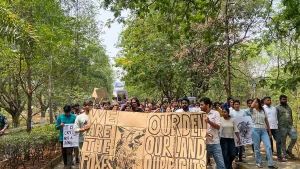
What is the Issue?
– The Telangana government intends to auction approximately 400 acres of land in the Kanchha Gachibowli area of Hyderabad Central University for the construction of an IT park.
– The government’s claim is that this IT park will attract an investment of 50,000 crores and generate 5 lakh jobs.
– Students and teachers are protesting the auction of the land. – Their argument is that the land has a dense forest, and its destruction would not only harm the university but also the city’s environment.
– In early April 2025, the government began clearing the forest using JCBs and other machines. This sparked significant protests, and the matter reached the Supreme Court.
Environmental Concerns:
– The Kanchha Gachibowli area is home to 237 species of birds, Indian star tortoises, chital deer, Indian rock pythons, and monitor lizards, among other wildlife species.
– Development in this area could destroy the habitats of these species.
– The land is one of the remaining urban forests in Hyderabad, playing a crucial role in the city’s environmental balance.
Legal Intervention
– Supreme Court’s Stay: After protests from students and environmental activists, the Supreme Court imposed an interim stay on the cutting of trees and directed the Telangana government not to fell any trees until further orders.
How Did It Happen?
– Under some of Telangana’s projects, forest land was converted for “non-forest use.”
– In several areas, trees were cut and encroachments were made without environmental clearance.
– The Environmental Impact Assessment (EIA) report was either ignored or not presented with full transparency.
Telangana Details
– CM: Revanth Reddy
– Capital: Hyderabad
Source: The Hindu
—————
7. When is World Health Day celebrated?
a. 7 April
b. 6 April
c. 5 April
d. 4 April
Answer: a. 7 April
Theme 2025
– Healthy beginnings, hopeful futures
– World Health Day is celebrated every year on the founding day of the World Health Organization (WHO).
– WHO was established on this day in 1948.
– WHO is an autonomous organization that works under the United Nations (UN) to promote global health issues.
– The main purpose of World Health Day is to raise awareness among people about the health issues that the world is grappling with.
—————
8. Which portal of India has been called a censorship portal by Company X, owned by Elon Musk, which the central government described as unfortunate and condemnable?
a. E-Governance Portal
b. Ayushman Bharat Portal
c. Sahyog Portal
d. CCC Portal
Answer: c. Sahyog Portal

– On March 28, 2025, the central government informed the Karnataka High Court that it was unfortunate and condemnable for X, a company owned by Elon Musk, to describe the Indian government’s “Sahyog” portal as a censorship portal.
What is the Sahyog Portal?
– In 2024, the Ministry of Home Affairs launched the Sahyog Portal to quickly implement orders to block objectionable content. The portal is maintained by the Indian Cyber Crime Coordination Centre (I4C).
Accounts Blocked in Digital Arrest Cases
– On March 26, Bandi Sanjay Kumar, the Minister of State for Home Affairs, stated in the Rajya Sabha that I4C had blocked 3,962 Skype IDs and 83,668 WhatsApp accounts in digital arrest cases.
– Additionally, by February 28, the government had also blocked 7.81 lakh SIM cards and 2,08,469 IMEI numbers.
– The term “Digital Arrest” is made up of two parts: “digital,” meaning virtual, and “arrest,” meaning detention. It refers to when someone is virtually detained, meaning they are confined to their home without physical arrest.
The Central Government Denies X’s Claims
– In a detailed response submitted to the court, the central government denied the claims made by X Corp in its petition challenging India’s information-blocking framework. The case is currently being heard in the High Court, which is addressing X’s challenge against the government’s use of Section 79(3)(b) of the Information Technology Act, 2000 (IT Act), to control and remove content on social media platforms. According to some news reports, the hearing is now scheduled for April 24.
What is X’s Issue with the Sahyog Portal?
– On March 5, 2025, X filed a lawsuit against the government, challenging the government’s directive to mandatorily include itself on the Sahyog Portal.
– X described it as a “censorship portal” that allows government officials to bypass judicial oversight and directly order content removal, thereby expanding India’s censorship powers.
– However, the government maintains that the Sahyog Portal is simply a tool to help comply with regulations, and it does not function as a censorship mechanism. No content is removed without due process.
How Many Apps Are Connected to This Portal?
– According to Indian Express, approximately 15 IT intermediaries or apps have now connected to the Sahyog Portal, including major platforms like Google, Meta, Telegram, Quora, Apple, and Amazon.
– 31 states and Union Territories have notified their officials and included them in the Sahyog Portal, in accordance with Section 79(3)(b) of the IT Act.
Source: Indian Express | Business Standard
—————
9. Actor Manoj Kumar passed away on 4 April 2025, in which year did he receive the Dadasaheb Phalke Award?
a. 1996
b. 1999
c. 2015
d. 2020
Answer: c. 2015
– He was 87 years old.
– Manoj Kumar was suffering from liver cirrhosis for a long time.
– He was also known by the nickname Bharat Kumar. Upkaar, Purab-Paschim, Kranti, Roti-Kapda Aur Makaan were his very successful films.
– Manoj Kumar’s real name was Harikrishna Goswami.
– He was born on 24 July 1937 in Abbottabad, British India (now Khyber Pakhtunkhwa, Pakistan).
Awards
1992: Padma Shri
2015: Dadasaheb Phalke Award
—————
10. Buddhist monks agitated demanding to free Mahabodhi Mahavihara in Bodh Gaya from non-Buddhist control and repeal of which Act?
a. Bihar Land Reforms Act, 1950
b. Bodh Gaya Temple Act, 1949 (BGTA)
c. Bihar Hindu Religious Trusts Act, 1950
d. None of these
Answer: b. Bodh Gaya Temple Act, 1949 (BGTA)
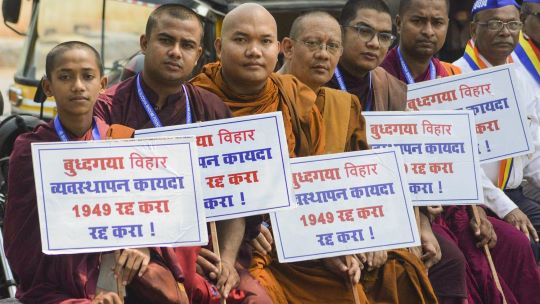
Why is the Protest Happening?
– Buddhists have been protesting since the past two months (since February 12, 2025) in Bodh Gaya, demanding that the Mahabodhi Mahavihara be freed from the control of Brahmin priests.
– The protesting Buddhists are demanding that the management of the place where Lord Buddha attained enlightenment should be under the control of a special Buddhist board.
– The protesters claim that recently, Hindu religious rituals are being promoted in the temple, which is unacceptable. They also argue that the Temple Management Board has an overrepresentation of Hindus, which goes against Articles 25 and 26 of the Indian Constitution, which guarantee freedom to choose, follow, and propagate religion.
Which Religious Places Have Members from Other Religions?
– The President of All India Buddhist Forum, Jambu Lama, stated to the media that their demand is very simple.
– He questioned why there are members from religions other than Buddhism in the Bodh Gaya Temple Management Committee (BTMC). He emphasized that only Buddhists should be members of the BTMC.
How Many Members Are There in BTMC?
– The Bodh Gaya Temple Management Committee (BTMC) consists of 9 members:
– 4 Buddhists
– 4 Hindus
– The District Magistrate (DM) of Gaya (who is the ex-officio chairperson of the committee).
About Mahabodhi Mahavihara
– The Mahabodhi Mahavihara is one of the most significant and sacred Buddhist sites, located in Bodh Gaya, Bihar, India.
– It is one of the four sacred sites in Buddhism:
1. Bodh Gaya (where Buddha attained enlightenment)
2. Lumbini (Nepal, the birthplace of Buddha)
3. Sarnath (Uttar Pradesh, where Buddha delivered his first sermon)
4. Kushinagar (Uttar Pradesh, where Buddha attained Parinirvana)
– The original temple was built by Emperor Ashoka in the 3rd century BCE (around 2300 years ago). The temple that stands today is from the 5th or 6th century and is one of the oldest brick Buddhist temples still standing from the end of the Gupta period.
– Inside the temple, there is an ancient Bodhi tree, under which Lord Buddha attained enlightenment.
– The Mahabodhi Stupa inside the temple marks the place where Buddha attained enlightenment.
The Four Sacred Sites in Buddhism
1. Bodh Gaya (Bihar) – Buddha attained enlightenment here.
2. Lumbini (Nepal) – Buddha’s birthplace.
3. Sarnath (Uttar Pradesh) – Buddha’s first sermon.
4. Kushinagar (Uttar Pradesh) – Buddha attained Parinirvana.
Source: The Hindu | The Lallantop

